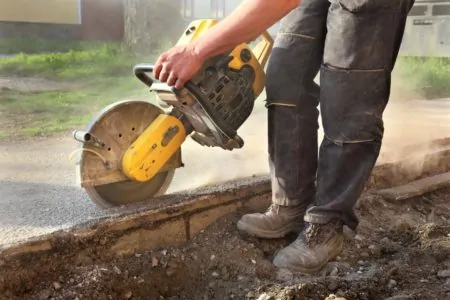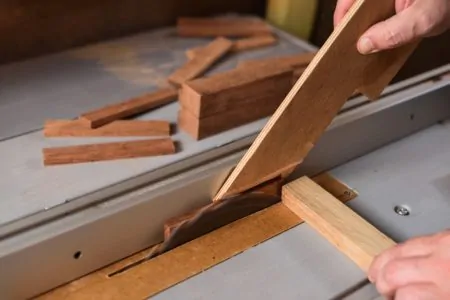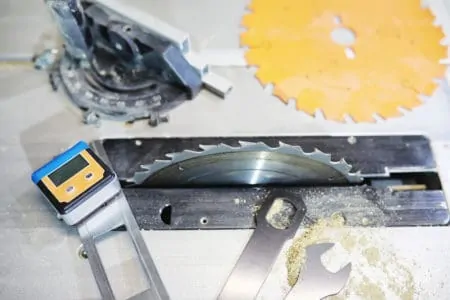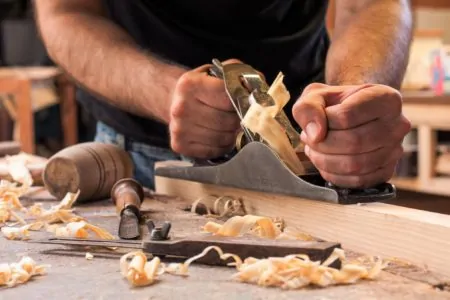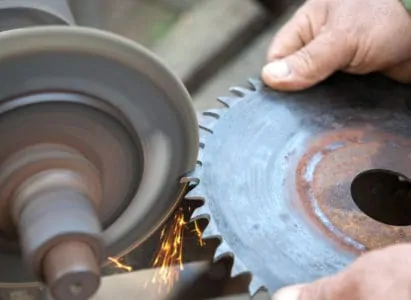Among the many tasks that you might need to tackle as a DIYer or professional contractor, cutting concrete can be one of the most intimidating. Concrete is a very hard material that is made to endure harsh conditions, so a standard saw blade won’t be able to cut it.
Thankfully, cutting concrete is no more difficult than other cutting jobs, as long as you use appropriate tools and employ the right techniques. If you have never done it before or just want some advice, you might need some guidance.
To help you, this article will explain how to cut concrete with a saw to achieve the best results. This includes when to cut it, which type of saw and blade to use, and a guide that will walk you through the cutting process.
Key Takeaways
- Wait at least 12-24 hours before cutting fresh concrete; weather can also affect the ideal cutting time.
- Choose the right saw blade, such as a diamond blade, for smooth and accurate cuts.
- Mark a cutting line with chalk or a chalk line for guidance and use safety equipment to protect yourself.
- Score an initial guideline, then gradually increase the cutting depth in 45-second intervals, allowing the blade to cool in between.
When Should You Cut Concrete?
When to cut concrete is influenced by several factors. These include the type of concrete you are cutting and how hard or abrasive it is. If you are cutting fresh concrete, you should wait for at least 12 to 24 hours before you start cutting it.
The weather also influences when you should cut concrete. On hot days, the concrete will react differently and set faster, so you may be able to start cutting after just 4 hours. If you are unsure whether or not it is ready, make a test cut and watch for any cracking or raveling, which happens when the aggregate below the surface is disturbed.
To be safe, you should wait a generous amount of time before cutting to preserve the integrity of the concrete and reduce the wear on your tools.
Where To Cut Concrete
If you are cutting larger sections of concrete, such as a driveway, determine where the joints are. Joints are typically 25 to 35 times the thickness of the slab. Typical joint spacing is 10 to 18 feet, depending on the level of reinforcement the slab has.
Other questions to consider when cutting concrete include:
- Can you form square patterns?
- Can you make continuous cuts?
- Are you cutting an area with reinforced steel rods joining one slab to another?
What Type of Saw Blade Should You Use?
You can use abrasive masonry blades to cut concrete, but they will dull very quickly. They may be cheaper to buy than specialist blades but you will likely end up spending more to replace these blades than if you simply buy one designed for the specific task.
Diamond Blades
Diamond blades have no teeth and are available in segmented or continuous-rim varieties. They have a diamond grit coating around the cutting rim of the blade that is extremely hard-wearing and resistant to high temperatures. They will outlast abrasive blades but also cost significantly more.
Dry Cutting Diamond Blade
Dry-cutting diamond blades are typically segmented to help scoop out debris as the blade cuts. It keeps them cool and helps the blade pass through the concrete more smoothly. As they are dry-cutting blades, expect a lot of dust to be released. If you are using these blades indoors, you will need to wear a protective mask and seal the room with duct tape to prevent dust from escaping.
Wet Cutting Diamond Blade
Wet-cutting diamond blades typically have a continuous rim and are kept cool with a stream of water. This lubrication helps wash away any debris and ease the blade through the material. Wet blades release less dust but you will need a saw that distributes water or an assistant to pour or spray water onto the concrete as you cut it.
How to Cut Concrete With a Saw
Before you start cutting concrete, make sure you have the necessary equipment to complete the job as safely and smoothly as possible. You should also wear protective equipment to prevent debris from getting into your eyes and lungs.
What You Need
- 1-inch-thick guideboard strip
- Drop cloths
- Duct tape
- Chalk or a chalk line
- Garden hose
- Broom
- Dustpan
- Wet/dry vacuum
- Sledgehammer
- Prybar
- Claw hammer (optional)
- Masonry chisel (optional)
- Dry-cutting diamond blade
- Wet-cutting diamond blade
- Ground fault circuit interrupter-extension cord
Protective Equipment
- Long pants and a non-baggy shirt
- Shin guards
- Knee pads
- Steel toe boots
- Goggles
- Ear defenders
- N95 face mask (filters out 95% of harmful particles)
1. Decide Which Blade to Use
A dry-cutting blade will enable you to use your standard circular saw. This means you won’t need to hire a wet saw or ask an assistant to keep applying a stream of water. The downside of a dry blade is its cutting depth. At best, you will be able to cut to a depth of 2.25 inches to 3 inches, depending on the size of the blade.
A wet-cut blade extends that cutting depth to between 4.5 inches and 8 inches. This means you should be able to make clean cuts all the way through the material without needing a chisel or a hammer. You will also have a longer, continuous cutting motion for cleaner cuts. As the blade is constantly cooled with water, there will be no need to keep stopping to let it cool down.
2. Preparing the Work Space
If you are working indoors, seal your doors and air intakes using drop cloths and duct tape. This will prevent the dust from escaping the room or contaminating other parts of your home where it could cause damage.
3. Mark the Line
Use a chalk line or a piece of chalk to mark the cutting line on the concrete. A chalk line is better for marking longer, straighter lines.
4. Protect Yourself
Put on your safety equipment and make sure you are wearing appropriate clothing. Don’t wear baggy shirts as they could get caught in the saw. Safety is vital when using heavy machinery to cut hard materials such as concrete. Wearing a mask is particularly important as the dust that will be released is highly toxic and will damage your lungs if inhaled.
You should also plug your saw into a GFCI-extension cord to protect yourself against power surges or the saw shorting out if it gets wet.
5. Get the Hose
If you are wet cutting and need to use a hose, place it so the water trickles over the surface you are cutting. This is important as you are using a power tool and need to avoid water getting inside it. Electricity and water don’t mix.
If you are cutting vertically, you may need to ask a friend to hold the hose in place over the surface.
6. Set Up the Saw
Lay the 1-inch-thick guide board along the cutting line. Next, place your saw at the point where you feel most comfortable starting and set the depth of the blade to 0.50 inches. This is the best depth for maintaining control of the saw while keeping the blade cool.
Quick Tip
7. Power Up the Saw
Activate the saw, making sure the motor is on its lowest revolutions per minute (RPM) setting. Start cutting along the line using the guide board for accuracy. Maintain a two-handed grip for greater stability and security.
Always let the saw work at its own pace and never try to force the blade to go faster or deeper. Making an initial cut to 0.25 inches will help you create an accurate line and provides a guide for deeper cuts later.
Quick Cuts
8. Remove the Saw
Remove the saw from the concrete and allow the blade to spin freely for a moment. This will help shake any debris from the blade and remove dust clogs from the saw. Always give the saw blade time to cool down.
Cool Off
9. Remove the Guide Board
Remove the guide board and reinsert the saw blade into the 0.25-inch cut. Work along it in 45-second bursts, steadily cutting deeper. You can gradually increase to a depth of 2 inches.
10. Collect the Dust
Even if you are washing away the dust, there will probably still be some left around the cut. Use a dustpan and brush to sweep it away. If you have a suitable vacuum, you can use it to remove the dust quickly and easily to keep your work area clean.
11. Adjust the Blade
Shut off the saw and use its depth lever to increase the blade depth by 0.50 inches. Repeat steps 7 and 8, carefully working along your cut again. Once you have reached your saw’s maximum depth, remove it from the concrete and switch it off.
If you have been using a “walk-behind” wet saw, you will probably have cut clean through the material and can skip the following steps.
12. Use the Sledgehammer
Clear the work area using a dustpan and brush or a vacuum cleaner. Leave your protective equipment on and grab the sledgehammer. Start by hitting the area 1 to 2 inches in front of the cut.
You will need to use meaningful force but don’t swing the hammer so hard that you can’t control it. As the concrete falls away, you can use a pry bar to remove any stubborn pieces.
Once you have removed the concrete along the cutting line, you can use a hammer and chisel to neaten any jagged edges. Place the chisel blade flush with the concrete and hit the top with the hammer. Each blow should be firm enough that the concrete breaks away into small pieces.
If you are pouring new concrete into the gap, it will be better to leave rough edges as they are, as this will give the new concrete something to bond with.
13. Time to Clean Up
Clean up the concrete debris. You can either use it to fill in your garden or take it to be disposed of at the appropriate location.
How Deep to Cut Concrete
You should aim to cut to about half or a third of the concrete’s thickness. If you cut too deep, the interlocking won’t be enough to bear the load, and if it is too shallow, cracks might appear.
Remember
Tips for Cutting Concrete With a Saw
- Choose the Right Blade: The most important part of cutting concrete is ensuring you use an appropriate blade. Whether you are cutting wet or dry, a diamond cutting blade will produce the best results.
- Score a Line: You might want to cut a guideline with a chisel before using your saw. This will give your blade something to bite into and helps you cut a straight line.
- Get the Timing Right: Unset concrete is difficult to cut, but it can be prone to fracturing if it hardens too much. The trick is to cut it while it is half-cured, as your work will be smoother and release less dust.
- Tape the Saw: Place duct tape on the base of your saw to prevent it from scratching the surface of the concrete as you cut. This is especially important when cutting polished concrete surfaces.
- Don’t Force the Blade: Allow the saw to dictate the pace it cuts at. Never try to force it to work faster as this will place greater stress on the saw. You also run the risk of it veering off course. Keep the RPM low and guide the saw gently as it cuts.
